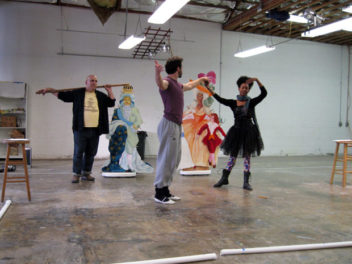
Evening view of América Tropical. Photo: Stacey Rain Strickler. Courtesy of the J. Paul Getty Trust
There are many myths and rumors about América Tropical, a monumental work created in Los Angeles by famed Mexican muralist David Alfaro Siqueiros. Some said that Siqueiros worked feverishly to complete the mural hours before its unveiling in 1932, with paint still wet on the plaster. Others said that the mural was censored because of the outrage it stirred in the city’s civic leaders for its content.
Here is what is known: the mural exists today as a powerful and tragic statement about imperialism in the Americas, was literally whitewashed not long after it was completed, and in the past decades was given new life by those dedicated to sharing its story.
Eight years ago this month, the Getty Conservation Institute completed a three-decade-long project to conserve the mural—carefully removing the paint that was used to cover it, working to save what was left, and making it accessible to visitors once again.
Here’s the story about the mural’s journey and its relevance today.
Siqueiros in Los Angeles

Portrait of David Alfaro Siqueiros in Lecumberri, México, D.F., 1960. Galería Fundación Héctor García, image licensed under a Creative Commons Attribution-NonCommercial-ShareAlike 4.0 International (CC BY-NC-SA 4.0)
Before moving to Los Angeles, Siqueiros was a known political activist who used his art to support the causes he believed in. Considered one of the three great Mexican Muralists, along with Diego Rivera and José Clemente Orozco, Siqueiros painted dynamic images of revolution and human struggle. His accentuation of the musculature of the human body was meant to show the strength of the working class (he was an avowed Communist), and he often used symbols from the natural world to evoke broader political and social themes. He has explained his approach by saying “the artist must paint as he would speak. I don’t want people to speculate what I mean, I want them to understand.”

La Nueva Democracia (1945) by David Alfaro Siqueiros at Palacio de Bellas Artes in Mexico City, Mexico. Wolfgang Sauber, image licensed under a Creative Commons Attribution-ShareAlike 3.0 Unported (CC BY-SA 3.0)
When he came to L.A., he brought together a group of artists and experimented with a number of innovative painting techniques that have become common today, such as airbrushing with spray guns. Siqueiros worked with the group on two murals, the first of which, titled Street Meeting, was located near MacArthur Park and was thought to be destroyed immediately after it was painted, due to its pro-Communist visuals and messaging.
Commission and Commotion
Siqueiros’ second commission was for the Plaza Art Center, where he was asked to create a mural on the second story of the Italian Hall on Olvera Street in downtown Los Angeles. It was supposed to offer a romanticized version of Mexico, one that ignored the vicious colonial aspirations of those who enslaved and killed its native people in favor of visions of prosperity and plenty. It is also notable that the mural would sit above Olvera Street, which is itself an idealized representation of a Mexican market street among buildings and sites from the city’s Spanish, Mexican, and early American periods.
However, the mural that was unveiled on October 9, 1932, revealed Siqueiros’ rejection of these quaint proposals.

Roberto Berdecio, a close associate of Siqueiros in the 1930s, in front of América Tropical in 1932 shortly after its completion. Mural: © Artists Rights Society (ARS)/SOMAAP, Mexico City. Photo: Getty Research Institute, Los Angeles
It shows a scene of Mayan ruins in an overgrown jungle, with a crucified Indigenous figure at its center. A menacing American eagle looms above, while two revolutionary soldiers take aim at the eagle from nearby. The mural’s message was clear—Siqueiros did not buy into the story he was asked to convey, and offered instead a scathing indictment of the powers that be.

Details of América Tropical, as it exists today. Left to right: Mayan ruins, revolutionary soldiers, and a crucified Indigenous figure. Photos: Stacey Rain Strickler. Courtesy of the J. Paul Getty Trust
Because there are no known color photographs of the mural, we’ll never know exactly what the mural looked like when it was completed. But the reaction to it was immediate. Some praised it for its brave depiction of an ignored aspect of history, while many decried it. Artist Millard Sheets recalled “some people really liked it thoroughly in every possible way, others were very much against it, feeling that it had something to do with political controversy or propaganda.”
Not long after the mural was completed, the section that depicted the soldiers that was visible from Olvera Street was painted over. Siqueiros was deported from the U.S. that same year for overstaying his visa. Eventually, the entire mural was whitewashed and forgotten.
América Tropical Reborn
It is difficult for history to stay buried forever, and for América Tropical, it was only a matter of time before the white paint began to come off. The rise of the Chicano mural movement in the 1960s coincided with the mural slowly reemerging, and a renewed interest in the work. Splashes of colors and hints of images began to surface, and before long almost the entire mural was revealed. However, years of neglect and exposure to the elements had taken their toll, and many of the vibrant colors in the mural were gone, leaving only outlines and suggestions of what was once there.
In 1988, the Getty Conservation Institute partnered with the City of Los Angeles to study and conserve the mural so it could once again be put on public display. Their work over the years included answering some of the most basic questions through scientific analysis, like what kind of materials and techniques Siqueiros used to create the mural. They also monitored the environment to determine the effect of atmospheric pollutants on the painting.

Conservation work on América Tropical in 2012. Photo: Stacey Rain Strickler. Courtesy of the J. Paul Getty Trust
Historical research also played a big part in the conservation process—digging through old news coverage, finding first-hand accounts around the time the mural was created, and searching for Siqueiros’ own words about it. To preserve the historical record, the mural was also photographed in detail so that these photos could be used as a guide for monitoring its condition. All these puzzle pieces came together to create an informed and appropriate conservation strategy.
Because the mural was abandoned for so many years, only so much of it could be salvaged. Current conservation practice dictates that the artist’s hand must be preserved as much as possible—meaning, essentially, that conservators would not repaint the mural.
Even without repainting, the mural’s project team had a lot of work on their hands. This included cleaning of the surface of the painting (think about how grimy the surface of your car is after a few weeks and multiply that by a few decades) and filling large material losses in the upper corners where the mural had been damaged in a 1971 earthquake. They removed the remaining whitewash, reattached paint and plaster to the brick wall the mural was painted on, and took off tar along the base of the mural from a previous roof repair. Finally, they strategically in-painted in places of damage and paint loss in order to reinstate the legibility of the composition. For a painting of this scale, which was deteriorated overall, the process was lengthy and took dozens of experts to complete.

Conservation work on América Tropical in 2012. Photo: Stacey Rain Strickler. Courtesy of the J. Paul Getty Trust
Another reason for the length of the project was the need to develop a protective shelter for the mural, which was in itself a complicated design process and an engineering challenge. A viewing platform also needed to be constructed to make it accessible to the public, and the adjacent building would need to be transformed into a place to tell the mural’s story.
On October 9, 2012, Getty and El Pueblo de Los Angeles came together to celebrate the opening of the América Tropical Interpretive Center. The center includes highlights of Siqueiros’ life and career, the history of the painting, and the road to conservation. Visitors can climb one floor to the outdoor platform, where they can view the mural from a distance. Getty also committed to routinely monitoring and cleaning the mural for another ten years.

Visitors inside the América Tropical Interpretive Center. Photo: Stacey Rain Strickler. Courtesy of the J. Paul Getty Trust
“The work that Getty has done to conserve and reopen América Tropical mural is a major contribution to the preservation of a vital part of history and art in Los Angeles,” says Arturo Chavez, general manager of El Pueblo de Los Angeles Historical Monument. “The thousands of visitors who viewed the mural pre-COVID is a testament to our successful collaboration.”
The Mural Today
Like many art institutions in the United States, the América Tropical Interpretive Center and mural are closed to the public due to the COVID-19 pandemic. However, staff are busy creating a plan for the handover of the mural’s management from the Conservation Institute to El Pueblo de Los Angeles in 2022. A complete monitoring plan will be published by Getty and will act as a model for monitoring other outdoor murals, and a new rolldown screen was recently installed to further protect the mural when it is off view. Getty will share news of the mural reopening as soon as it is available.
You can find out more about the mural and its conservation with these videos.




“The work that Getty has done to conserve and reopen América Tropical mural is a major contribution to the preservation of a vital part of history and art in Los Angeles,” I would go further and say that this is a contribution to the history and art of the United States as a whole. It is past time that all Americans learn the devastating history of colonialism, including the U.S. manifest destiny doctrine. Not only is this a wonderful piece of art that deserves to be seen throughout the country, it is a clear indictment of the harm we, as imported citizens, have done to the original citizens of the Americas. Good work Getty.
The Phansi ubuntu art museum in Durban South Africa is trying, together with the surviving original artists to do something about the heroic mural of the South African Bill of Rights that they painted onto the prison wall and which was2 years ago painted over by the municipality. The painting happened over a period of years and began with the Universal Rights, painted over with the Interim Bill of Rights until the Final ones were approved by all. The walls are the perimeter walls of the prison where most of our struggle heroes from this area were incarcerated. The prison has been demolished and replaced with the international conference center.
Any Ideas?